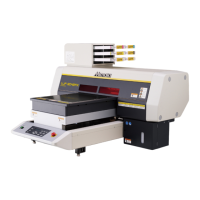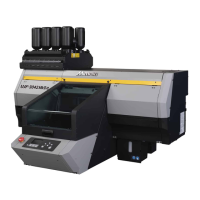4-2
Chapter 4 Cutting Function
Cut Out Data with Reg-
ister Mark
Create register marks on an output image that you want to
make a seal, and the machine detects them to cut them
out.
There are the following three types of register marks.
The Flow of Cutting out the Regis-
tered Data
Enter register mark detection mode
1
Press (TEST CUT) in LOCAL.
2
Press to select “MARK
DETECTION”, and press the key.
• The machine enters register mark detection
mode.
Precautions for inputting data with
register marks
There are some limitations to preparing data with register
marks.
In order to make full use of this function, read the following
instructions carefully to correctly prepare data with
register marks.
Size of register marks
In addition, for the length of one the side of the register
mark compared to the data, refer to "Size of and distance
between register marks" ( P.4-4).
Make sure that the line width of the register mark is larger
than 1/10 the length of register mark.
• Use the TP4 when performing trapezium compen-
sation to correct the uneven sheet feeding rate
caused by the difference in the diameter between
the right and left grit rollers. If the trapezium com-
pensation is to be omitted, there is no need to set
the TP4. In that case, however, cutting distortion
will increase.
register mark: Type 1
register mark: Type 2
register mark: Zero Margin
Add register marks to the
image that you want to make a
seal, and print it on a sheet.
Set the printed sheet in the
machine.
Send the cut-target image from
the computer for cutting.
There are some
conditions for creating
register marks.
See pages P.4-2
through P.4-4.
Refer to P.2-4 to set
the sheet.
In case it is not
successfully cut,
• Check the register
mark sensor.
• Check the position
of the Light Pointer.
• When register detection is set to OFF, the machine
doesn’t enter register mark detection mode.
(P.4-5)
• While various functions are being set, data entry
may be canceled and the machine may go back to
the previous setting item.
• The register mark described here is intended to
detect the sheet inclination and the lengths along
the X and Y axes. It is not a mark for trimming.

